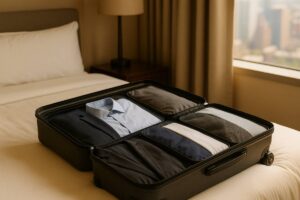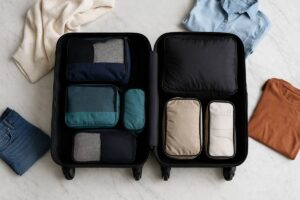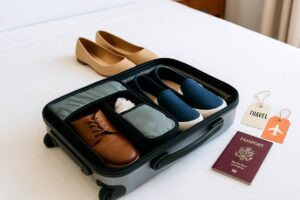Ever found yourself squeezing in that extra souvenir only to watch your spinner bulge at the gate?
Expandable carry-ons solve that packing panic with a hidden gusset that boosts capacity by 10–25%—enough for a sweater or two more without checking luggage.
From hard-shell polycarbonate expandables that shrug off dings to soft-side suitcases with handy external pockets, today’s designs blend durability with flexibility. But before you unzip for extra space, know the rules—most U.S. airlines cap carry-ons at 22 × 14 × 9 inches (45 linear inches).
Let’s unpack why expandables are a game-changer—and when they might backfire.
Understanding Expandable Carry-On Features
Expandable carry-ons transform fixed-size luggage into versatile packers’ best friend, offering anywhere from a modest 10% boost to a full 25% extra space when unzipped. In luggage design, “expandable” refers to a built-in extension feature—usually a zipper gusset—that, when opened, adds depth or height to the bag without altering its core dimensions.
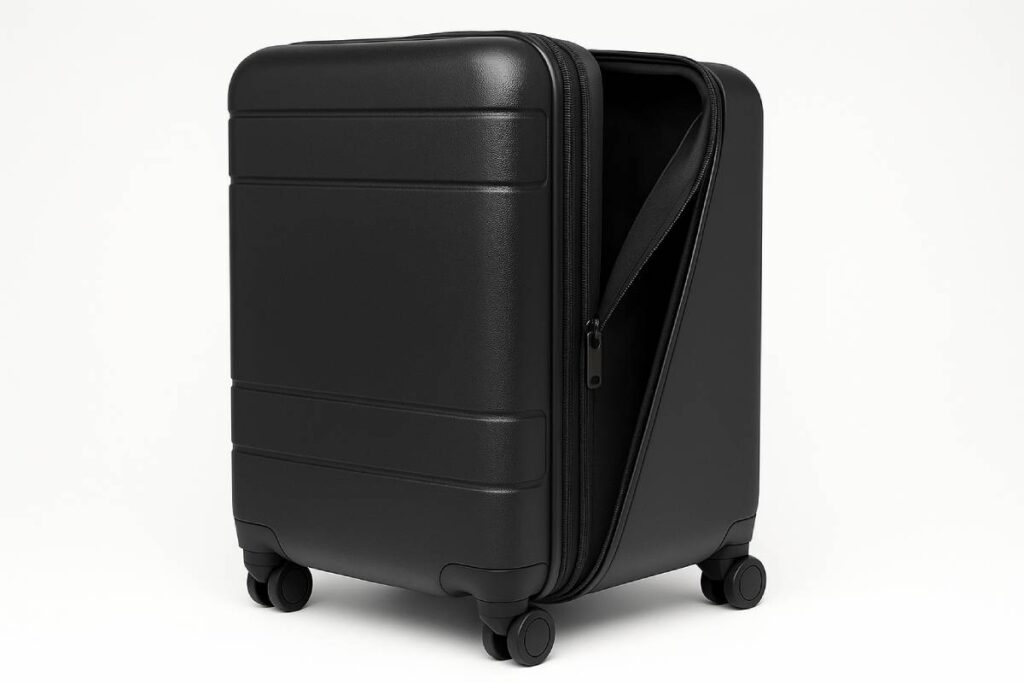
The most common mechanism is a wrap-around zipper gusset: a hidden fabric panel that unfolds to increase volume.
A less widespread but innovative approach uses fold-out panels or pop-up fabric sections that snap into place, as seen on some premium collections like Travelpro’s Platinum Elite series, which offers clamshell designs and fold-out suitors for added room.
Material and construction quality also plays a pivotal role: heavy-duty gussets made from 1260D nylon and robust YKK reverse-coil zippers can withstand repeated expansion cycles, while cheaper fabrics may fray or weaken over time.
Many brands—like Monos—pair their gussets with aerospace-grade polycarbonate shells for impact resistance and long-term durability.
Premium lines even undergo rigorous lab tests in outlets such as Travel + Leisure’s testing facility to ensure scratch and impact resilience before releasing expandable models to the market.
Definition and Mechanisms
“Expandable” luggage integrates an extra-space feature—most often a hidden gusset—that, when unzipped, increases the interior volume without altering the suitcase’s core frame. This allows travelers to stay within airline size limits when compact, and then add room for souvenirs or last-minute items by releasing the extra panel.
- Zipper Gussets: The industry standard for expansion, zipper gussets conceal a fabric panel around the perimeter. When unzipped, the panel unfolds to add depth (and sometimes height) to the bag. This mechanism balances ease of use with structural integrity, leveraging high-tensile fabrics and heavy-duty zippers to prevent tearing.
- Fold-Out Panels: Featured in select premium collections, fold-out panels (or pop-up sections) expand via hinged seams or snaps rather than a continuous zipper. Travelpro’s Platinum Elite line, for example, incorporates fold-out suitors and clamshell designs for seamless expansion, though such systems can add complexity and cost.
Typical Expansion Capacities
Most expandable carry-ons offer 10–25% more packing volume:
| Model | Base Volume | Expanded Volume | Expansion (%) | Gusset Material |
|---|---|---|---|---|
| Amazon Basics 21″ Spinner | 41 L | ~51.25 L | 25% | Standard nylon gusset |
| Away Carry-On Flex | 47.9 L | 53.5 L | ~11.7% | Built-in zipper gusset |
These percentages translate into anywhere from a couple extra outfits for a weekend trip to enough space for souvenirs on longer journeys. Note that some brands—like Away—conservatively estimate 10–15% gains upon full expansion to ensure carry-on compliance.
- Material & Gusset Quality: The longevity of an expandable feature hinges on fabric toughness and zipper durability. Brands using 1260D nylon gussets (e.g., Monos) and YKK reverse-coil zippers deliver superior resistance to wear and tear, while lower-end models with thin panels can fray or pinch, reducing lifespan.
By understanding these mechanisms and capacity ranges, travelers can choose an expandable carry-on that balances added space with reliable performance—key to stress-free journeys and seamless airport experiences.
Airline Size Compliance and Regulations
In today’s travel landscape, knowing exactly what counts as a “legal” carry-on can save you from last-minute gate checks and surprise fees. This comprehensive size guide reveals that in the U.S., virtually every major carrier caps carry-on dimensions—wheels and handles included—at 22 × 14 × 9 inches, or 45 linear inches (length + width + height).
International airlines often quote their own metric standards (e.g., 55 × 40 × 25 cm for many European and Asian carriers), while budget lines may shrink allowances further or add weight caps (e.g., 55 × 35 × 25 cm, 10 kg max on some low-cost routes).
Expansion zippers can push a bag’s depth beyond compliant limits—if a suitcase advertises 10 inches but has a 2 inch gusset, you’re suddenly at 12 inches deep—so always measure both before and after expanding and pack with smart strategies (compression cubes, vacuum-seal bags, Tetris-style loading) to avoid oversize charges.
Standard U.S. Domestic Limits
Most U.S. carriers—including American Airlines and Alaska Airlines—require carry-ons to measure no more than 22 × 14 × 9 inches (56 × 36 × 23 cm), with wheels and handles factored into these dimensions. This translates to a 45 linear-inch rule (L + W + H ≤ 45 inches), ensuring bags fit uniform overhead bins.
A few low-cost domestic airlines—Southwest and Frontier among them—relax one dimension slightly (up to 24 × 16 × 10 inches) but often impose fees for oversized carry-ons.
| Airline | Max Dimensions (H × W × D) | Linear Inches | Notes |
|---|---|---|---|
| American Airlines | 22 × 14 × 9 in | 45 in | Standard allowance |
| Alaska Airlines | 22 × 14 × 9 in | 45 in | Standard allowance |
| Southwest Airlines | 24 × 16 × 10 in | 50 in | Fees apply for excess |
| Frontier Airlines | 24 × 16 × 10 in | 50 in | Fees apply for excess |
International and Low-Cost Carriers
Globally, carry-on limits vary widely:
- Major international airlines typically allow 55 × 40 × 25 cm (≈ 22 × 15.7 × 9.8 inches) to accommodate overhead bins on wide-body jets.
- Budget carriers often tighten those to 55 × 35 × 25 cm (≈ 21.7 × 13.8 × 9.8 inches) and may impose a 10 kg (22 lb) weight cap, plus separate personal-item rules.
Because each airline—and even individual routes—can differ, always verify carry-on limits on the airline’s official website before packing.
Impact of Expansion on Compliance
Expandable carry-ons boost capacity by 10–25%, but that extra depth can quietly tip your bag past legal limits:
- Measure twice: Record your suitcase’s length, width, and depth before and after fully unzipping the gusset to see if you exceed the 45 linear-inch threshold.
- Pack smart: Use compression packing cubes or vacuum-seal bags to maximize space without overstuffing.
- Tetris-style loading: Place heavier items at the bottom, fill gaps with socks or electronics, and keep bulky toiletries minimized to avoid bulging seams.
By understanding these rules and employing strategic packing techniques, you’ll breeze through boarding with a compliant, expandable carry-on—no unexpected gate checks required.
Material Quality and Durability
Material quality and durability are non-negotiable when investing in an expandable carry-on. Hard-shell designs built from polycarbonate deliver superior impact resistance and scratch protection compared to ABS alternatives, while soft-side models offer more flexibility, external pockets, and ease of squeezing into tight overhead bins.
Rigorous tests by Travel + Leisure confirm that the Amazon Basics Hardside Spinner withstands baseball-bat and drop trials without dent or scratch; meanwhile, New York Post’s Texas ranch “off-road” trial proves that the TravelPro Platinum Elite series endures even the roughest terrain.
Warranty coverage varies: TravelPro’s “Built for a Lifetime” promise and 10-year limited plans eclipse Away’s one-year limited warranty, and broad repair networks ensure your bag can be serviced globally.
Below, we’ll break down hard-shell versus soft-side expandables, dive into durability testing insights, and compare warranty offerings so you can choose a travel companion that’s as resilient as your itinerary.
Hard-Shell vs. Soft-Side Expandables
Hard-shell luggage typically uses polycarbonate or ABS plastics, with polycarbonate offering higher impact resistance and a lighter weight profile at a slightly higher cost. ABS is more budget-friendly but can be prone to cracking or visible scratches over time. In contrast, soft-side expandables are constructed from textiles like ballistic nylon or polyester, providing:
- Flexibility: Soft-side shells compress slightly to fit irregular spaces and often include zippered expansion panels.
- External Pockets: Quick-access compartments for boarding passes, water bottles, and electronics.
- Lightweight Feel: Generally lighter out of the box, though they may sag or lose shape when fully packed.
| Feature | Hard-Shell (Polycarbonate) | Hard-Shell (ABS) | Soft-Side Expandable |
|---|---|---|---|
| Impact Resistance | High – flexes under force without cracking | Moderate – stiffer and more brittle | N/A – relies on fabric toughness |
| Scratch Visibility | Low on textured finishes | High on glossy surfaces | Fabric scuffs, less noticeable |
| Weight | 6–8 lbs (2.7–3.6 kg) | 6–9 lbs (2.7–4.1 kg) | 4–6 lbs (1.8–2.7 kg) |
| Expansion Mechanism | Zipper gusset | Zipper gusset | Zipper gusset or panel |
| External Storage | Minimal | Minimal | Multiple pockets |
| Average Price | $150–$400 | $80–$200 | $100–$300 |
Durability Testing Insights
Travel + Leisure subjected the Amazon Basics Hardside Spinner to repeated baseball-bat strikes and drop tests, reporting zero dents or scratches on its thick thermoplastic shell. This budget model defied expectations, maintaining structural integrity after three rounds of impact testing over two years.
The New York Post took the TravelPro Platinum Elite series to a Texas ranch for off-road trials, where its textured polycarbonate shell resisted gouges and maintained smooth spinner-wheel performance across rocky terrain. MagnaTrac® wheel systems and leather-accented handles further withstood abuse without loosening or degrading.
Warranty and Manufacturer Support
Warranty terms can make or break the long-term value of your carry-on:
| Brand | Warranty Type | Duration | Coverage Highlights |
|---|---|---|---|
| TravelPro® Platinum Elite | Built for a Lifetime | Lifetime defect coverage* | Wheels, zippers, extension handles; includes airline damage promise |
| TravelPro® Core & Other | Limited Warranty | 10 years (main lines) 5 years (select duffels) | Repair or replace defects; excludes misuse |
| Away Carry-On Flex | Limited Warranty | 1 year | Manufacturing defects only; customer pays return shipping |
| Amazon Basics Spinner | No formal warranty | Manufacturer support varies | Amazon handles returns within purchase windows |
* TravelPro’s Trusted Companion Promise even covers airline-inflicted damage and shipping costs for repairs.
Most top brands back their warranties with global repair networks—TravelPro maintains service centers in 40+ countries, and Away partners with authorized repair shops in major hubs like London, New York, and Tokyo.
Always register your luggage upon purchase to streamline future claims and take advantage of periodic preventive maintenance offers.
By weighing these material, testing, and warranty factors, you’ll ensure your expandable carry-on withstands the rigors of travel and keeps pace with your adventures—trip after trip.
Capacity and Space Utilization
Expandable carry-ons strike a balance between compact convenience and extra room for last-minute items. The Amazon Basics 21″ Hardside spinner boasts a hidden gusset that delivers up to 25% more packing space when unzipped, while Away’s Carry-On Flex adds 2.25 inches of depth—enough for an extra pair of shoes or folded sweater.
Thoughtfully designed interiors—with dividers, mesh pockets, and compression straps—keep your wardrobe organized and accessible. Yet overpacking remains a common pitfall: travelers report heftier gate-check fees, strained seams, and wasted space from throwing in “just in case” items. The solution?
A disciplined packing list paired with packing cubes, which segment outfits, compress fabrics, and are essential for maximizing space in every inch of your expandable carry-on.
Base vs. Expanded Volume
Expandable carry-ons typically advertise a 10–25% increase in capacity. For example:
| Model | Base Depth | Expanded Depth | Expansion Mechanism | Expansion (%) |
|---|---|---|---|---|
| Amazon Basics 21″ Spinner | 9 in | ~11.25 in | Hidden zipper gusset | Up to 25% amazon.com |
| Away Carry-On Flex | 9 in | 11.25 in | Wraparound expandable zipper | +2.25 in |
This extra space can mean the difference between checking a bag and carrying it on with ease.
Organization Features
Interior layouts are crucial for making that expanded volume truly usable:
- Dividers & Panels: The Amazon Basics 21″ spinner includes a full-coverage divider panel to keep folded items in place amazon.com.
- Mesh Pockets: Built-in mesh compartments make it easy to stash toiletries or electronics without digging through layers amazon.com.
- Compression Straps: Elastic cross-straps secure bulkier garments against the shell, preventing shifting and creasing.
These features turn raw volume into organized packing zones, ideal for separating clean clothes from worn items or shoes from linens.
Overpacking Risks and Best Practices
Even the most generous gussets can backfire if you overload them:
- Traveler Warnings: Overpacked suitcases frequently exceed airline weight limits—triggering extra fees and gate checks—and can cause zipper failures when fully expanded.
- Mindset Shift: Many packers admit they include items “just in case,” only to leave them untouched and take up valuable space.
- Best Practice: Packing Cubes
- Segment & Compress: Packing cubes let you group outfits or garment types, compressing fabrics by up to 30% in some models.
- Visibility & Access: Mesh-top cubes give a quick view of the contents, so you don’t unzip the entire suitcase to find your socks.
By combining measured expansion with strategic organization—packing cubes, dividers, and straps—you’ll unlock the full potential of your expandable carry-on without risking fees or damage.
Price Range and Value Breakdown
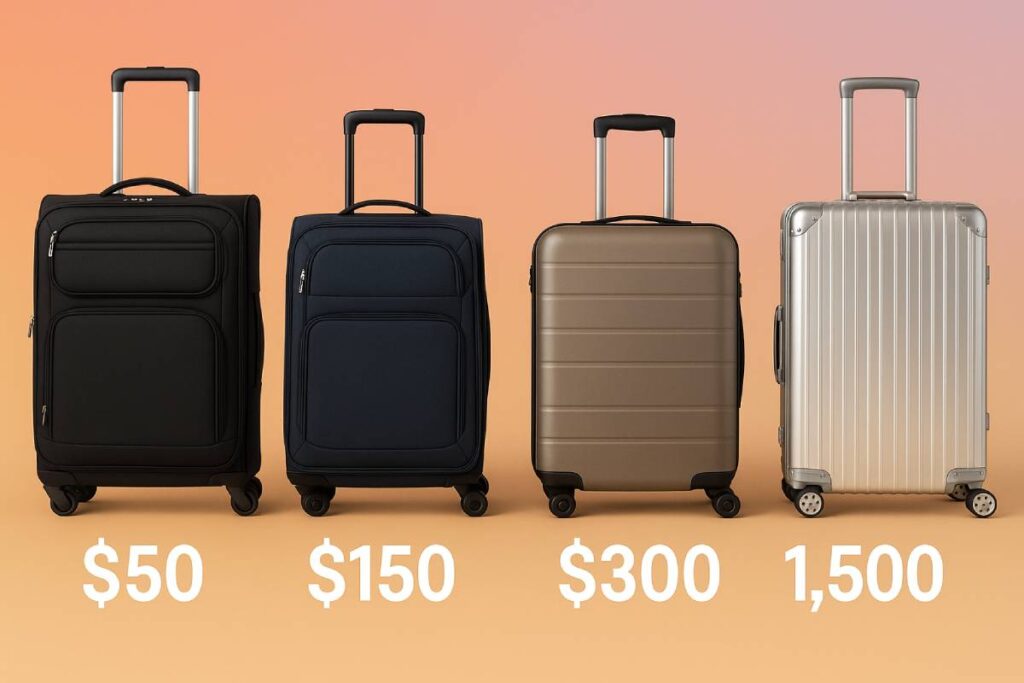
In today’s luggage market, expandable carry-ons span a wide price spectrum to match every traveler’s needs.
On the budget end, the Amazon Basics 21″ Hardside spinner delivers up to 25% more space for just $57.40, making it an unbeatable value for infrequent flyers or cost-conscious shoppers.
Stepping up to the mid-range, the TravelPro MaxLite 5 Expandable Spinner balances lightweight durability with organizational extras, listing at $144.49 on TravelPro’s site and noted at $170 by GQ as a top soft-side pick.
For those seeking premium build quality and warranties, Away’s Bigger Carry-On sits at $295 with a limited lifetime warranty, while the ultimate luxury choice—Rimowa’s Classic Cabin Carry-On—starts at $1,525, offering an aluminum shell and heritage design.
Budget Options ($50–$100)
| Model | Price | Pros | Cons |
|---|---|---|---|
| Amazon Basics 21″ Hardside Spinner | $57.40 | Highly affordable; scratch-resistant surface; Amazon’s Choice | Minimal interior organization; no TSA lock on standard model |
| Amazon Basics 21″ with TSA Lock | $62.99 | Added security lock; robust build | Slightly higher cost; still limited pocketing amazon.com |
Mid-Range Picks ($100–$300)
| Model | Price | Key Features |
|---|---|---|
| TravelPro MaxLite 5 Expandable Spinner | $144.49 (MSRP) | Ultra-light fabrics; PowerScope Lite handle; 360° spinners |
| (GQ Pick) TravelPro MaxLite 5 | $170 | Best soft-side luggage; practical organization |
- Lightweight construction: Weighs just 5.4 lbs (21″ spinner), easing airport lifts.
- Organizational pockets: Multiple interior and exterior zip compartments plus adjustable hold-down straps keep clothes tidy.
Premium Models ($300+)
| Model | Price | Highlights |
|---|---|---|
| Away Bigger Carry-On | $295 | Durable polycarbonate shell; limited lifetime warranty; free returns |
| Rimowa Classic Cabin Carry-On | $1,525 | High-end aluminum build; telescoping leather-inset handle; 36 L capacity |
- Away’s warranty: Limited lifetime coverage on shells and defects (battery covered for 30 days) ensures peace of mind.
- Rimowa’s craftsmanship: Precision-engineered with anodized aluminum, offering a heritage design backed by a robust service network.
By aligning your budget with the right feature set—whether it’s essential durability at $57, balanced functionality at $145–170, or premium assurance at $300+—you’ll find an expandable carry-on that maximizes value and travel confidence.
Feature Comparison Matrix
When it comes to choosing the right expandable carry-on, a clear feature comparison matrix helps you weigh mobility, durability, and creature comforts at a glance. Below is a side-by-side look at the key components, followed by deep dives into each category.
| Feature | Option A | Option B | Notes |
|---|---|---|---|
| Wheel Type | Dual-spinner (2 larger wheels) | Quad-spinner (4 small, 360° swivel wheels) | Dual-spinners roll straight ahead; quad spinners offer effortless omnidirectional glide |
| Telescoping Handle | Basic telescoping rods (aluminum, 2-stage) | Multi-stage aluminum tubes with ergonomic grips | Most handles lock into 2-3 heights; premium models add cushy silicone grips |
| Zipper System | Standard nylon coil zipper | YKK reverse-coil zipper | High-end zippers stay smooth through thousands of cycles; cheaper zips snag over time |
| Gusset Integrity | Standard nylon gusset | Heavy-duty 1260D nylon gusset | Premium gussets resist fraying and panel collapse even after repeated expansion |
| USB Port | – | Yes (TravelPro Platinum Elite) | Convenient external USB port for on-the-go charging |
| Cup/Phone Holder | – | Yes (Wrangler Smart Carry-On) | Integrated fold-out cup and phone holder keeps essentials handy |
| Weight Indicator | – | Yes (Béis Carry-On Roller) | Built-in gauge shows when you’re over airline weight limits |
Mobility Components
Dual-spinner wheels use two larger wheels that roll smoothly in a straight line but require a slight tilt when changing direction, making them ideal for uneven surfaces like cobblestones. In contrast, quad-spinner wheels swivel a full 360°, allowing the bag to glide beside you with minimal effort—perfect for weaving through crowded airport terminals.
A robust telescoping handle further enhances maneuverability. These handles typically consist of hollow aluminum tubes that collapse into each other and lock via spring-loaded pins, offering two to three height settings to reduce back strain.
Expansion Systems
A smooth, snag-free zipper is the backbone of any expandable carry-on. Premium models use YKK reverse-coil zippers, prized for their corrosion resistance and buttery-smooth glide even after thousands of open-close cycles. In contrast, entry-level zippers often feature basic nylon coils that can catch or wear thin over time.
Equally important is the gusset material. Standard nylon gussets provide basic expansion, but 1260D ballistic nylon gussets—common in high-end lines—maintain their shape under load, resisting frays and panel collapse even after repeated unzippings. Just as industrial gusseted packaging relies on side or bottom gussets to stand upright underweight, luggage gussets must preserve structural integrity to prevent unbalanced bulges.
Additional Conveniences
- Built-in USB ports (TravelPro Platinum Elite) let you charge devices directly from an onboard battery pack, a boon during long layovers.
- Integrated cup and phone holders (Wrangler Smart Carry-On) flip out of the side panel, keeping your beverage and smartphone within arm’s reach at security checkpoints.
- Weight indicators (Béis Carry-On Roller) display a red “overweight” mark if you exceed your target, so you can rebalance before you get to the gate—and dodge hefty fees.
By comparing these components side-by-side, you can zero in on the expandable carry-on that best balances smooth mobility, lasting durability, and modern conveniences—ensuring a stress-free journey from check-in to the carousel.
Pros and Cons: Is Expandability Worth It?
Expandable carry-ons can be a game-changer for savvy travelers—offering the flexibility you need for last-minute purchases and souvenirs while often sparing you the hassle and expense of checking a bag.
Yet, that extra zip-out gusset can land you in oversized-fee territory if you’re not careful, and the reinforced seams and heavier shells inevitably add a few pounds to your load. Whether you’re a business jet-setter, a family on the go, or a first-time flyer, understanding these trade-offs helps you match your travel style to the right expandable carry-on.
Key Advantages
- Flexibility for last-minute buys or souvenirs: Expandable models like the July Carry-On Light hold up to 40 L—among the most in its class—so you can bring home extra treasures without checking a second bag.
- Avoids a separate checked bag: Carry-on-only travel slashes average checked luggage fees ($30–$35 per bag) and speeds up both arrival and departure.
Potential Drawbacks
| Drawback | Details | Citation |
|---|---|---|
| Risk of oversize fees | Airlines strictly enforce linear-inch limits; unzipping an extra inch can trigger $100+ gate-check fees or forced checking | reddit.com |
| Weight & bulk increase | Extra gusset panels and reinforced zippers add 0.5–1 lb, pushing many expandables over the ideal 7 lb carry-on threshold | onebag.com |
Traveler Profiles
Choose your expandable carry-on based on who you are and how you travel:
| Profile | Recommended Model | Why It Works | Citation |
|---|---|---|---|
| Business Traveler | Delsey Paris Turenne 2.0 Expandable Carry-On | Sleek design, quick-access pockets for documents, blends professional style with expandability. | sfgate.com |
| Leisure Explorer | July Carry-On Light Expandable | Ultra-light (under 5 lb), up to 40 L capacity, ideal for weekend getaways and low-key adventures. | july.com |
| Family Pack | Antler Icon Stripe Carry-On With Expander | Durable for all weather, roomy expander for extra kids’ gear, water-resistant shell. | sfgate.com |
| First-Time Flyer | Amazon Basics 21″ Hardside Spinner | Budget-friendly at $57; reliable 25% extra space; straightforward features for stress-free travel. | sfgate.com people.com |
By weighing these pros and cons—and aligning your bag choice with your travel persona—you’ll determine whether the squeeze of an expandable carry-on truly pays off, or if a traditional fixed-size spinner is the smarter bet for your next trip.
Customer Ratings and Expert Opinions
Below is a roundup of real traveler feedback and trusted expert evaluations to help you weigh the customer love and professional endorsements for top expandable carry-ons.
Most travelers applaud the Amazon Basics 21″ Hardside Spinner for its unbeatable value—boasting a 4.4-out-of-5 star average from 52,748 global ratings, thanks to its spaciousness, smooth wheels, and durable ABS shell.
The TravelPro Platinum Elite Hardside Spinner follows closely with a 4.1-out-of-5 star score based on 1,056 reviews, praised for its scratch-resistant polycarbonate shell and MagnaTrac® wheels.
Frequent-flyer forums and the New York Post highlight TravelPro Platinum Elite as a top pick among business travelers—citing its rugged performance even on a Texas ranch test.
Real User Ratings Snapshot
| Model | Rating | Number of Reviews |
|---|---|---|
| Amazon Basics 21″ Hardside Spinner | 4.4 / 5 stars | 52,748 |
| TravelPro Platinum Elite Hardside Spinner | 4.1 / 5 stars | 1,056 |
Authority Reviews
Travel + Leisure Lab Tests
Travel + Leisure’s gear lab subjects luggage to drop, scratch, and maneuverability trials, concluding that models like the Aer Carry-On (48 L capacity, Makrolon polycarbonate) hold up with only minor scuffs while the organization system keeps contents secure under stress. Their methodology evaluates capacity, durability, design, and value across 59 carry-on models to guide serious travelers.
Forbes & The Strategist Recommendations
- The Strategist (New York Magazine) names the Away Bigger Carry-On its top hard-shell choice for durability, 47.9 L capacity, lifetime warranty, and smooth spinner wheels, while also commending budget options like Amazon Basics for value.
- Forbes Vetted crowns the Away Bigger Carry-On “Best Carry-On Luggage” for its blend of expandability, hardshell protection, and convenient size.
- Forbes Personal Shopper also highlights the Calpak Hue Mini Carry-On for compact expandability and the TravelPro MaxLite 5 as the top lightweight expandable spinner under 6 lbs.
Combining high user satisfaction with rigorous lab and editorial endorsements, these insights make clear which expandable carry-ons deliver both everyday reliability and expert-level performance.
Buying Guide & Final Recommendations
Here’s your streamlined buying guide and final recommendations—designed to help you zero in on the perfect expandable carry-on for your travel style. We’ll walk you through a decision checklist, spotlight our top picks across budgets, and suggest cross-sell accessories to round out your gear.
Most U.S. airlines cap carry-on size at 22 × 14 × 9 inches (including wheels and handles), equivalent to a 45 linear-inch limit; always verify your specific carrier’s policy before purchase.
Decision-Making Checklist
- Confirm airline limits: Check your carrier’s website for exact height, width, depth, and any weight caps.
- Assess base & expanded size: Compare the suitcase’s stated dimensions with and without expansion—for example, the Amazon Basics 21″ spinner measures 21.7 × 14.8 × 10 inches expanded (25% more) versus 21.7 × 14.8 × 9 inches base amazon.com.
- Evaluate material: Hard-shell polycarbonate offers superior impact resistance; soft-side textiles provide flexibility and extra pockets.
- Compare warranties: A limited lifetime warranty (e.g., Away’s lifetime coverage on the shell, wheels, handles, zippers) outpaces 1–5 year plans.
- Set budget: Determine your price range—budget ($50–$100), mid-range ($100–$300), or premium ($300+)—and prioritize features accordingly.
Top Picks by Category
| Category | Model | Price Range | Why It’s Best |
|---|---|---|---|
| Best Budget Expandable | Amazon Basics 21″ Hardside Spinner | $57 | Up to 25% extra space, durable ABS shell, interior divider |
| Best Mid-Range | TravelPro MaxLite 5 Expandable | $144–$170 | Ultra-light (5.4 lbs), 46 L capacity, organizational pockets |
| Best Premium | Away Bigger Carry-On | $295 | Polycarbonate shell, lifetime warranty, scratch-resistant finish |
Cross-Sell Opportunities
| Accessory | Benefit | Source |
|---|---|---|
| Packing Cubes | Segment outfits, compress fabrics, boost organization by up to 30% | Outside Online |
| TSA-Approved Locks | Secure your bag with airline-recognized locks, and avoid forced cut-offs amazon.com | Amazon |
| Luggage Tags | Durable silicone or leather tags for easy identification amazon.com | Amazon Best Sellers |
By following this checklist and choosing one of our top-rated expandable carry-ons—paired with smart packing cubes, TSA locks, and a sturdy tag—you’ll travel lighter, stay organized, and breeze through security and boarding with confidence.
Seasonal Considerations & Next Steps
When to buy and how to pack make as much difference as which bag you choose. Summer peaks and holiday rushes can drive prices up and inventory down, yet well-timed sale events (Prime Day, Black Friday, Prime Big Deal Days) regularly discount luggage by 50–60%.
Meanwhile, record Independence Day travel brings 72.2 million U.S. trips in a single week and Thanksgiving sees 79.9 million travelers over one holiday period—straining both overhead bins and carry-on stock.
A mobile-first approach—using the MyTSA app for instant size-rule checks and price-tracking tools like those highlighted by The Points Guy—lets you snag the best deals without overshooting airline limits. Finally, clear calls to action—“Shop Now,” “Compare Models,” and “Subscribe for Gear Alerts”—turn reader interest into confident purchases.
Peak Demand Periods
Summer Travel Surges & Holiday Packing Needs
- Independence Day spike: AAA forecasts 72.2 million Americans traveling between June 28–July 6, 2025—a 1.7 million increase over last year.
- Thanksgiving record: Nearly 80 million U.S. travelers (a 2 million rise from 2019) hit the roads and skies in late November.
- Year-end holidays: AAA expects 119.3 million Americans to travel 50+ miles for Christmas through New Year’s—up 3 million from 2023.
How to Time Your Purchase for Sale Events
| Sale Event | Dates (2025) | Typical Luggage Discounts | Tip |
|---|---|---|---|
| Amazon Prime Day | July 8–11 | Up to 50% off on top brands | Sign up for Prime and set deal alerts |
| Prime Big Deal Days | Early Oct | Up to 50% off | Compare with past Prime Day lows |
| Black Friday/Cyber Monday | Late Nov/Early Dec | Up to 70% off | Stack with store-credit coupons |
Mobile-First Shopping Tips
- MyTSA App: Instantly verify carry-on size rules, bin-fit guidelines, and airport delay alerts on your phone.
- Size-Rule References: Apps like Kayak and NerdWallet (via MyTSA links) list linear-inch limits (22×14×9 inches = 45 linear inches) for domestic and international carriers.
- Price Tracking Tools: Browser extensions and websites (Honey, CamelCamelCamel, Keepa) notify you when luggage prices hit your target, as detailed by The Points Guy.
| CTA Type | Example Text | Best Practice Source |
|---|---|---|
| Shop Now | “Shop Now – Save Up to 50%!” | HubSpot recommends direct e-commerce CTAs |
| Compare Models | Interactive chart | NN/g advises clear comparison tables; Baymard on UX for comparison tools |
| Newsletter Signup | “Get Travel Gear Alerts” | HubSpot’s email newsletter examples |
By aligning your purchase with peak-season insights, leveraging mobile tools to respect airline rules and chase the best prices, and using proven CTAs, you’ll secure the ideal expandable carry-on at the right time—and never miss a deal.
Conclusion
Expandable carry-ons bridge the gap between minimalism and over-preparedness—letting you carry those impulse buys home without the hassle of checking a bag. By unzipping a hidden gusset, you unlock up to 25% more space, perfect for souvenirs or extra layers on cooler nights. Yet expandability isn’t risk-free: that extra inch can trigger gate-check fees when you exceed the 45 linear-inch limit most U.S. airlines enforce.
Choosing the right model means balancing shell material, weight, and warranty. Hard-shell polycarbonate cases shrug off impacts, while soft-side textiles offer external pockets for quick-access essentials. Price points range from Amazon Basics at $57 to luxury Rimowa cabins at $1,525, so align your budget with must-have features.
Finally, pack smart: compression cubes boost organization and help you stay within limits. With these insights, you’ll select an expandable carry-on that safeguards your gear—and your wallet—on every adventure.
FAQs
What makes a carry-on “expandable”?
An expandable suitcase includes a secondary zipper gusset or fold-out panel that, when unzipped, unfolds a fabric insert to increase interior depth by up to 2–3 inches (10–25% volume gain).
Will expansion void my airline’s size rules?
It can. Always measure your bag before and after expanding—go over 45 linear inches (22 + 14 + 9) and you risk gate-check fees of $50–$100.
Are hardshell or softside expandables better?
Hard-shells (polycarbonate) excel in impact resistance; soft-sides (nylon/polyester) offer external pockets and may compress slightly to squeeze into tight bins.
Do packing cubes really help?
Yes—studies show cubes can compress clothing by up to 30%, improve organization, and speed up security checks by keeping items visible in mesh panels.
Which expandable carry-on model tops the list?
Budget travelers love the Amazon Basics 21″ spinner ($57); mid-range fans pick the TravelPro MaxLite 5 ($144); luxury seekers favor the Away Bigger Carry-On ($295, lifetime warranty).




















